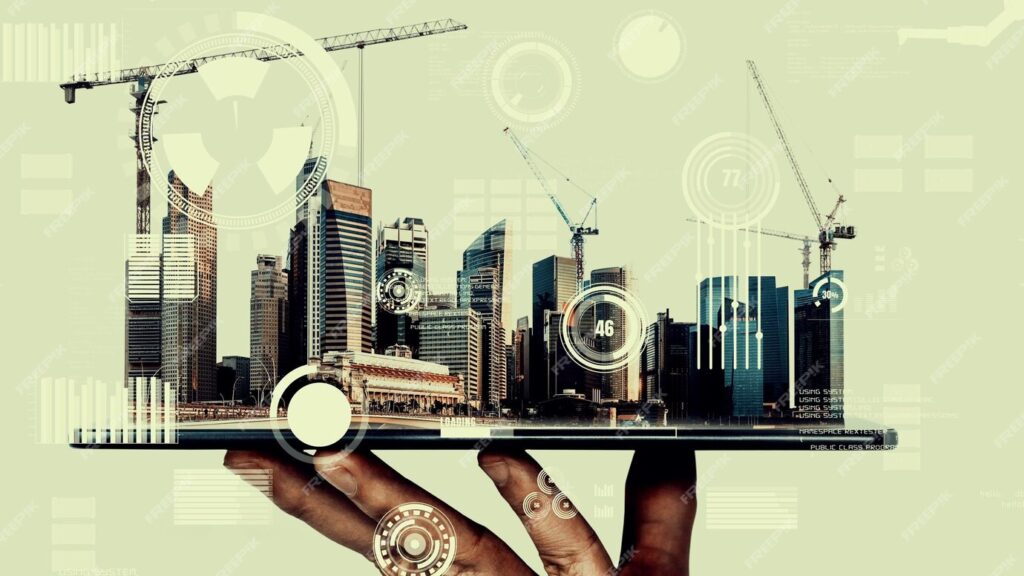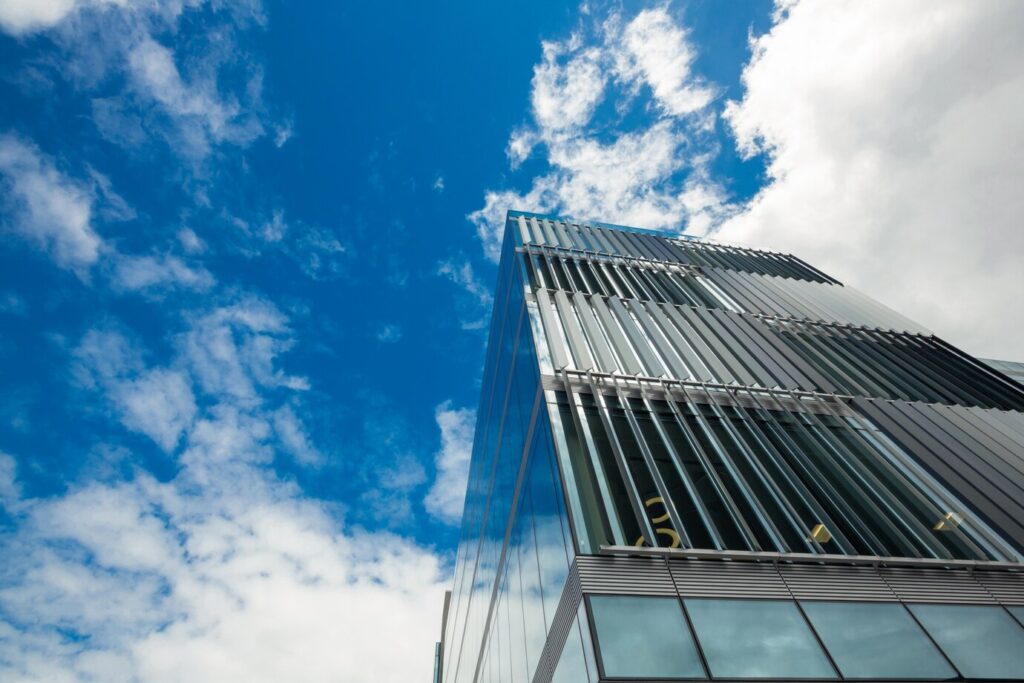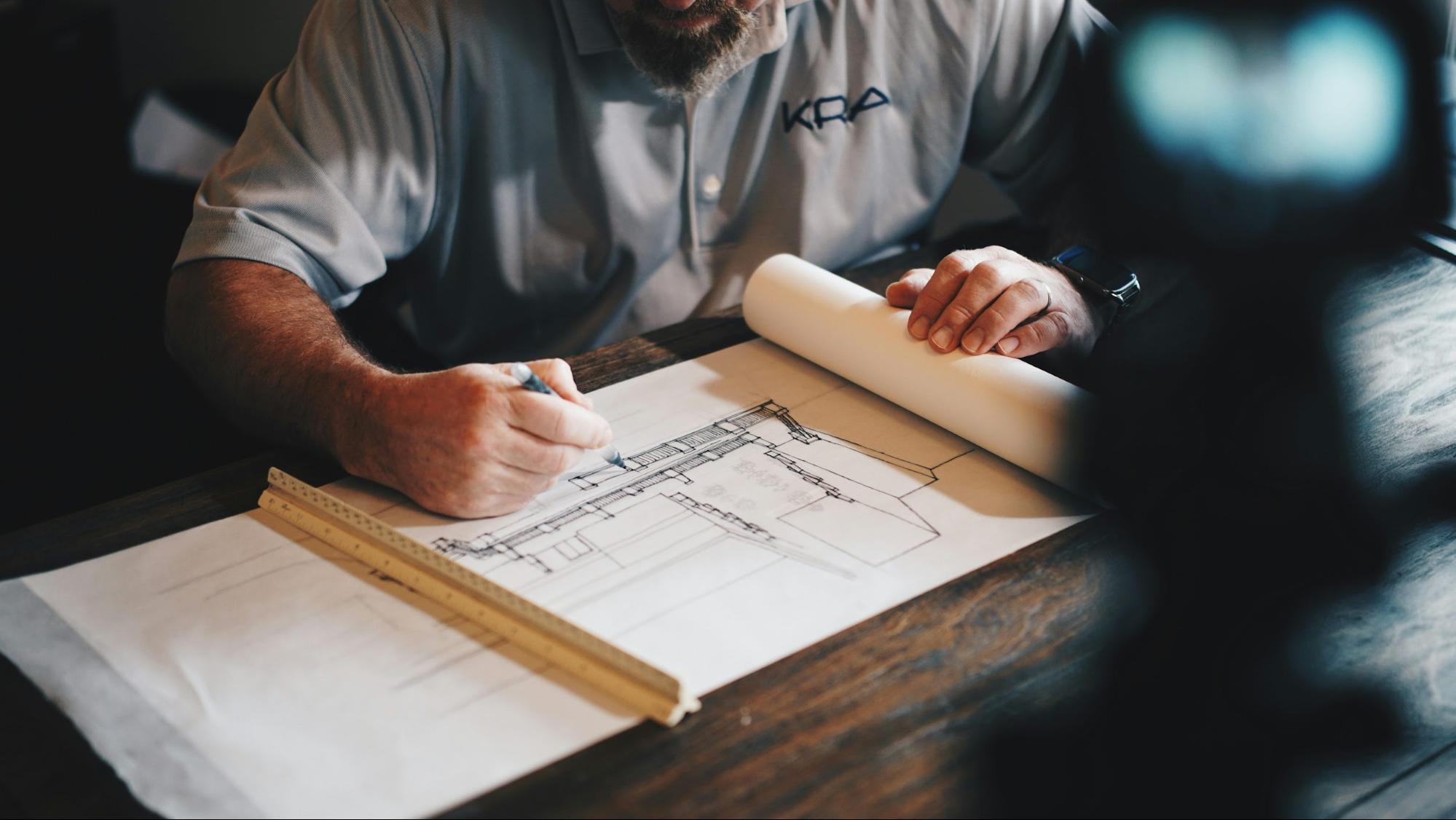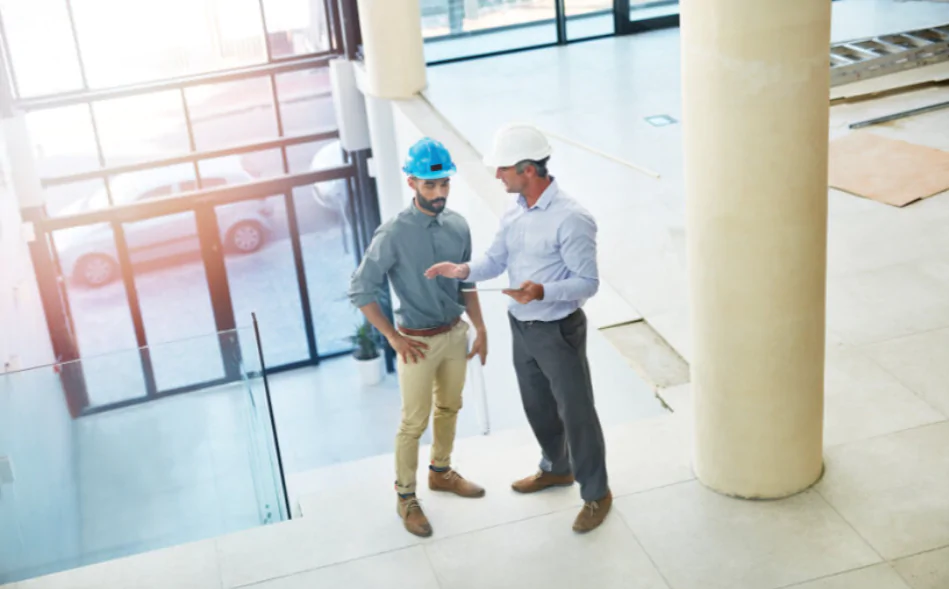
Businesses must stay informed about the latest trends in commercial construction to improve efficiency, sustainability, and profitability.
New technologies, materials, and practices are reshaping how commercial spaces are designed and built. These advancements, such as eco-friendly solutions and AI-driven project management, set the stage for a more innovative and cost-effective future.
The demand for smarter, greener, and more resilient buildings continues to grow, driven by stricter regulations, changing market expectations, and a stronger focus on environmental impact.
Businesses that fail to adapt to these shifts risk falling behind their competitors.
This article will explore the top trends in commercial construction for 2025. Understanding these trends ensures compliance with industry standards and optimizes construction costs and long-term operational efficiency.
Sustainability is one of the main trends in commercial construction
One of the most promising trends in commercial construction for 2025 is the increasing emphasis on sustainability.
In response to growing environmental concerns and stricter regulations, businesses are prioritizing eco-friendly construction methods.
Sustainable construction:
- Benefits the environment.
- Enhances property market value.
- Improves energy efficiency.
- Meets customer expectations for greener business operations.
Eco-friendly materials and energy-efficient designs
Companies want to minimize waste and maximize efficiency, leading to a growing demand for sustainable materials.
Builders now use recycled steel, bamboo, and low-carbon concrete to construct durable and environmentally responsible structures. Additionally, energy-efficient design strategies, such as natural ventilation and passive solar heating, reduce energy consumption in commercial buildings.
One of the standout trends in commercial construction is the growing adoption of green roofs and solar panel systems.
Green roofs
Green roofs, or living roofs, consist of a layer of vegetation planted over a waterproofing system on top of a building.
These innovative roofing solutions are natural insulators, which lowers energy demands for heating and cooling. Additionally, green roofs improve air quality by filtering pollutants and capturing carbon dioxide.
Another key benefit is stormwater management. Traditional roofs contribute to rapid runoff, overwhelming drainage systems and increasing the risk of flooding. Green roofs absorb and slowly release rainwater, easing the burden on urban drainage infrastructures.
Beyond functional advantages, green roofs also create natural spaces that can be used for relaxation, meetings, or urban agriculture, adding economic and social value to commercial properties.
Solar panels
Solar panel systems are fundamental for energy-efficient commercial construction.
These systems capture sunlight and convert it into electricity, reducing dependence on traditional power grids. As energy costs continue to rise, solar technology provides a long-term, cost-effective solution to lower expenses.
Modern solar panels have improved efficiency and affordability, making them an attractive option for commercial buildings. Companies can benefit from tax incentives, rebates, and renewable energy credits to offset installation costs.
Furthermore, integrating battery storage solutions allows businesses to store excess energy for later use, enhancing reliability and reducing vulnerability to power outages.
Businesses can align with the latest trends in commercial construction by incorporating green roofs and solar panels into commercial projects.
These solutions lower operational costs and improve corporate social responsibility, attracting eco-conscious clients, tenants, and investors.
The role of LEED certification in construction planning
Leadership in Energy and Environmental Design (LEED) certification is a key requirement for sustainable construction.
Projects that meet LEED standards enjoy benefits such as tax incentives, increased marketability, and improved tenant satisfaction.
Buildings must adhere to strict environmental criteria to achieve certification. Each standard contributes to a more sustainable and energy-efficient structure:
Energy efficiency
Buildings must incorporate high-performance insulation, energy-efficient HVAC systems, and smart lighting solutions to minimize energy consumption.
Renewable energy sources, such as solar and wind power, can contribute to higher certification levels.
Water conservation
LEED-certified projects implement water-efficient plumbing fixtures, rainwater harvesting systems, and drought-resistant landscaping to reduce water usage.
Greywater recycling and low-flow appliances help optimize water consumption.
Sustainable site development
Site selection is crucial in LEED compliance, encouraging building development in areas that minimize environmental disruption.
Projects often prioritize access to public transportation, bicycle storage, and pedestrian-friendly infrastructure to reduce carbon emissions.
Material selection and waste management
Recycled, locally sourced, and non-toxic materials help reduce the environmental footprint.
Construction waste management plans ensure that materials are reused or recycled rather than sent to landfills.
Indoor environmental quality
Proper ventilation, low-emission building materials, and natural lighting contribute to healthier indoor air quality. LEED encourages the design of spaces that promote occupant comfort, well-being, and productivity.
Many companies are incorporating LEED guidelines to ensure compliance and maximize sustainability benefits.
Understanding these requirements connects the project with trends in commercial construction, meeting the current and future industry standards.
Sustainable construction methods in action
Innovative construction techniques are also reshaping the industry. Prefabrication and modular construction, for example, reduce waste and lower construction costs by using factory-controlled manufacturing processes.
Prefabrication
Prefabrication involves manufacturing building components in a controlled factory environment before transporting them to the construction site for assembly. This method offers several advantages:
- Less material waste: Factory-controlled production optimizes material use, significantly reducing excess waste compared to traditional on-site construction.
- Faster project completion: Since different building components are fabricated simultaneously, construction timelines are shortened, leading to earlier occupancy and quicker ROI.
- Improved quality control: Manufacturing in a controlled setting ensures consistent quality, reducing defects and rework.
- Lower environmental impact: Prefabrication minimizes disruption to the construction site, reducing noise pollution, dust, and transportation emissions.
Modular construction
Modular construction takes prefabrication a step further by producing entire sections or modules of a building in a factory before transporting them for final assembly. Key benefits include:
- Energy efficiency: The precise manufacturing process minimizes energy use and improves insulation and airtight construction, reducing heating and cooling demands.
- Cost savings: Modular buildings typically require fewer labor hours on-site, lowering overall costs while maintaining high durability.
- Adaptability and reusability: Modules can be repurposed or expanded, allowing businesses to adjust spaces based on evolving needs without major reconstruction.
Smart Building Technology
Smart building technology is essential in sustainable development beyond innovative construction techniques. Integrated energy management systems, automated lighting controls, and real-time monitoring help optimize resource use and improve operational efficiency.
- Energy Management Systems (EMS) track and regulate energy consumption, ensuring that heating, cooling, and electricity usage are optimized based on occupancy and external conditions.
- Automated Lighting Controls adjust brightness and turn off lights in unoccupied areas, reducing electricity consumption.
- IoT-Connected Sensors monitor air quality, temperature, and humidity to enhance indoor environmental quality while minimizing energy waste.
Companies that embrace these trends in commercial construction can become industry leaders as sustainability becomes a defining factor in modern development.
Technological advancements are trends in commercial construction

Technology revolutionizes how projects are designed, managed, and executed. Among the most transformative trends in commercial construction for 2025 is the adoption of these resources to enhance efficiency, precision, and safety.
Digital modeling and automated construction methods are just some of the numerous innovations setting new standards for the industry.
Building Information Modeling (BIM)
Building Information Modeling (BIM) is a digital representation of a building’s physical and functional characteristics, allowing teams to visualize every aspect of a project before breaking ground.
BIM enhances collaboration between architects, engineers, and contractors. With real-time data, it is possible to reduce costly design errors and streamline project timelines.
This technology is essential for optimizing material usage, improving sustainability efforts, and ensuring compliance with building codes.
As one of the dominant trends in commercial construction, its ability to simulate real-world conditions before execution reduces risk and enhances project results.
Drones
Drones provide real-time aerial site monitoring, topographic mapping, and progress tracking. These unmanned aerial vehicles (UAVs) offer a cost-effective way to conduct site inspections and reduce manual labor in potentially hazardous areas.
Beyond safety improvements, drones also contribute to efficiency. They help track material deliveries, measure progress, and ensure construction aligns with the original blueprints.
3D printing
Another innovation is 3D printing, making commercial construction more efficient and cost-effective.
This technology allows entire building components to be prefabricated using specialized materials, reducing waste and labor costs.
3D printing is expected to play an even larger role in commercial construction, from producing custom architectural elements to creating entire modular structures.
Technology in commercial construction from now on
The use of artificial intelligence for predictive maintenance, robotics for automated construction, and IoT-enabled smart buildings are just a few emerging trends in commercial construction that will define the industry’s future.
The future of commercial construction is digital, and businesses that leverage these advancements will lead the way in efficiency, sustainability, and innovation.
Demands shaping trends in commercial construction

As industries evolve, so do their requirements for commercial spaces.
The shifting needs of healthcare, retail, and office environments are driving some trends in commercial construction for 2025. Developers and contractors must adapt to these demands to create functional, efficient, and future-proof spaces.
Healthcare
The healthcare sector demands innovative construction solutions to accommodate advanced medical technologies and evolving patient care models.
Hospitals, urgent care centers, and outpatient clinics are being designed with modular layouts that can be reconfigured as needs change.
Another priority in healthcare construction is infection control. Enhanced ventilation systems, antimicrobial surfaces, and touchless technology are becoming standard features in new healthcare facilities.
Retail
E-commerce has reshaped the retail market, driving demand for multi-purpose retail spaces that blend physical and digital shopping experiences.
Retailers want locations that support omnichannel strategies, incorporating areas for in-store shopping, click-and-collect services, and micro-fulfillment centers.
Additionally, experiential retail is influencing trends in commercial construction, with brands investing in immersive store designs that enhance customer experience.
Construction firms must embrace flexibility to meet the needs of modern retail businesses, like integrating smart dressing rooms or creating pop-up-style layouts.
Office spaces
Hybrid work models are the new norm and are transforming the traditional office space.
Employers prioritize adaptive workspaces that can easily shift between collaborative and private environments.
Key design elements driving these changes include:
Flexible partitions and modular furniture for customizable layouts.
Improved indoor air quality through smart HVAC systems.
Biophilic design incorporating natural light and greenery to enhance employee well-being.
New England: A hub for market-driven construction
The demand for adaptive spaces is particularly strong in New England.
Historic buildings are frequently repurposed into mixed-use developments, and sustainability remains a top priority.
Developers in Boston and surrounding areas are embracing trends in commercial construction for 2025 projects.
One example is the growing use of modular construction for office buildings and retail spaces. Prefabricated components allow for faster assembly while reducing costs and environmental impact.
This method is popular among developers looking for efficiency without sacrificing quality.
The future of market-specific trends in commercial construction
As industries continue to evolve, so will the trends in commercial construction that define their spaces.
Contractors who understand these changing demands and integrate flexible solutions will remain at the forefront of the industry.
Whether it’s healthcare, retail, or office environments, aligning construction strategies with market needs is key to long-term success.
Follow the trends in commercial construction
The trends in commercial construction are reshaping the industry in 2025.
Sustainability is no longer an option but a necessity, with businesses prioritizing eco-friendly materials, energy-efficient designs, and LEED-certified buildings.
Meanwhile, technological advancements like BIM, drones, and 3D printing are streamlining project execution, enhancing precision, and reducing costs.
Additionally, evolving market demands in healthcare, retail, and office spaces require more flexible, adaptive, and innovative construction solutions.
At Goveias Construction, we are at the forefront of these industry transformations.
We integrate cutting-edge solutions that meet the latest trends in commercial construction, ensuring that every build is sustainable and efficient.
Our team is ready to bring your vision to life with innovative strategies and high-quality execution. Contact us today for a free quote!




